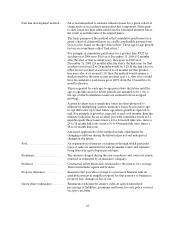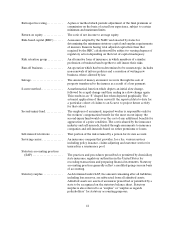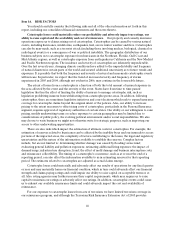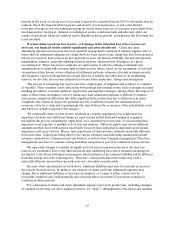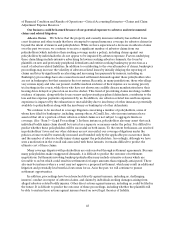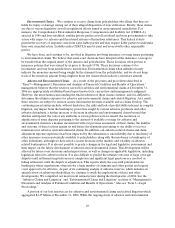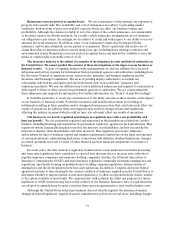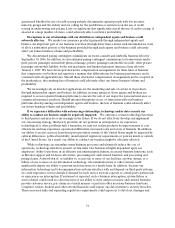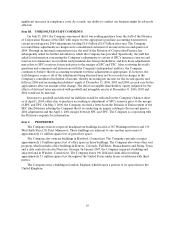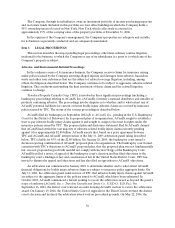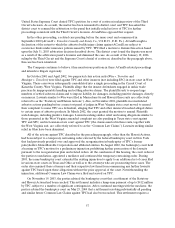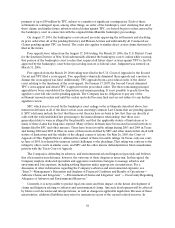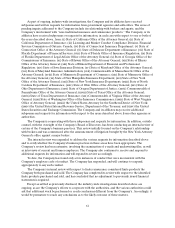Travelers 2006 Annual Report Download - page 63
Download and view the complete annual report
Please find page 63 of the 2006 Travelers annual report below. You can navigate through the pages in the report by either clicking on the pages listed below, or by using the keyword search tool below to find specific information within the annual report.51
Reinsurance may notprotect us against losses. We use reinsurance to help manage our exposure to
property and casualty risks. The availability and cost of reinsurance are subject to prevailing market
conditions, both in terms of price and available capacity, which can affect our business volume and
profitability. Although the reinsurer is liable to us to the extent of the ceded reinsurance, we remain liable
as the direct insurer on all risks reinsured. As a result, ceded reinsurance arrangements do not eliminate
our obligation to pay claims. Accordingly, we are subject to credit risk with respect to our ability to recover
amounts due from reinsurers. In addition, some of our reinsurance claims may be disputed by the
reinsurers, and we may ultimately receive partial or no payment. This is a particular risk in the case of
claims that relate to insurance policies written many years ago, including those relating to asbestos and
environmental claims. Reinsurance may not protect us against losses and may not be available to us in the
future at commercially reasonable rates or at all.
The insurance industry is the subject of a number ofinvestigations by state and federal authorities in
the United States. We cannot predict the outcome of these investigations or the impact on our business or
financial results. As part of ongoing, industry-wide investigations, we and our affiliates have received
subpoenas and written requests for information from government agencies and authorities, including from
the AttorneysGeneral ofnumerous states, various states’ insurance and business regulators and the
Securities and Exchange Commission. The areas of pending inquiry addressed to us include our
relationship with brokers and agents and our involvement with “non-traditional” insurance and
reinsurance products. We and our affiliates may receive additional subpoenas and requests for information
with respect to these or other areas from government agencies or authorities. We are cooperating with
thesesubpoenas and requests for information. For further information, see “Item 3—Legal Proceedings”.
It would be premature to reach any conclusions as to the likely outcome of these matters or the impact
on our business or financial results. Potential outcomes could include enforcement proceedings or
settlements resulting in fines, penalties and/or changes in business practices that could adversely affect our
results of operations. In addition, these investigations may result in changes in laws and regulations
affecting the industry in general which could, in turn, also adversely affect our results of operations.
Our businesses are heavily regulated and changes in regulation may reduce our profitability and
limit ourgrowth. We are extensively regulated and supervised in the jurisdictions in which we conduct
business, including licensing and supervision by government regulatory agencies in such jurisdictions. This
regulatory system is generally designed to protect the interests of policyholders, and not necessarily the
interests of insurers, their shareholders and other investors. This regulatory system also addresses
authorization for lines of business, capital and surplus requirements, limitations on the types and amounts
of certain investments, underwriting limitations, transactions with affiliates, dividend limitations, changes
in control, premium rates and a variety of other financial and non-financial components of an insurer’s
business.
In recent years, the state insurance regulatory framework has come under increased federal scrutiny,
and some state legislatures have considered or enacted laws that may alter or increase state authority to
regulate insurance companies and insurance holding companies. Further, the National Association of
Insurance Commissioners (NAIC) and state insuranceregulators continually reexamine existing laws and
regulations, specifically focusing on modifications to holding company regulations, interpretations of
existing laws and the development of new laws and regulations. In addition, Congress and some federal
agencies from time to time investigate the current condition of insurance regulation in the United States to
determine whether to imposefederal or national regulation or to allow an optional federal charter, similar
to the option available to most banks. We cannot predict with certainty the effect any proposed or future
legislation orNAIC initiativesmay have on the conduct of our business. Insurance laws or regulations that
are adopted or amended may be more restrictive than current requirements or may result in higher costs.
Although the United States federal government does not directly regulate the insurance business,
changes in federal legislation, regulation and/or administrative policies in several areas, including changes



